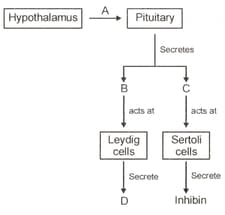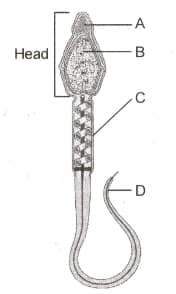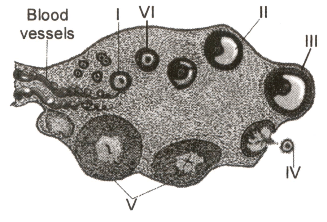Mammary glands are paired structures that contain the glandular tissue and variable amount of fat. The correct sequence of tissues involved in synthesis and flow of milk is
Mammary ampulla Mammary duct
Lactiferous duct
Lactiferous duct
Mammary duct Mammary ampulla
Lactiferous duct
Lactiferous duct Mammary ampulla
Mammary duct
Lactiferous duct Mammary duct

Important Questions on Human Reproduction
Study the flow chart. Name the hormones labelled as at each stage.

Choose the correct option.
| (1) | Androgen | |||
| (2) | Androgens | |||
| (3) | Gonadotropins | Testosterone | ||
| (4) | Androgens |
Given below are four statements each with one or two blanks. Select the option which correctly fill up the blanks in two statements:
A. The human male ejaculates about (i) million sperms during a coitus. Out of which, for normal fertility at least
(ii) percent sperms must have normal shape and size.
B. A primary spermatocyte completes
(i) meiotic division leading to the formation of two equal haploid cells called (ii)
C. Spermatogenesis starts at the age of (i) due to significant increase in the secretion of (ii) a hypothalamic hormone.
D. Oogenesis is initiated during embryonic development and at puberty only
(i) primary follicles are left in each ovary.
Which of the following labelled parts produces energy for the movement of the tail that facilitates sperm motility essential for fertilisation?

The figure given below depicts a diagrammatic sectional view of ovary. Which one set of three parts out of are correctly identified?

Which one of the following is the correct matching of the events occurring during menstrual cycle?
Identify the hormones that are secreted in large amount prior to ovulation
A.
B.
C. Estrogen
D. Progesterone
